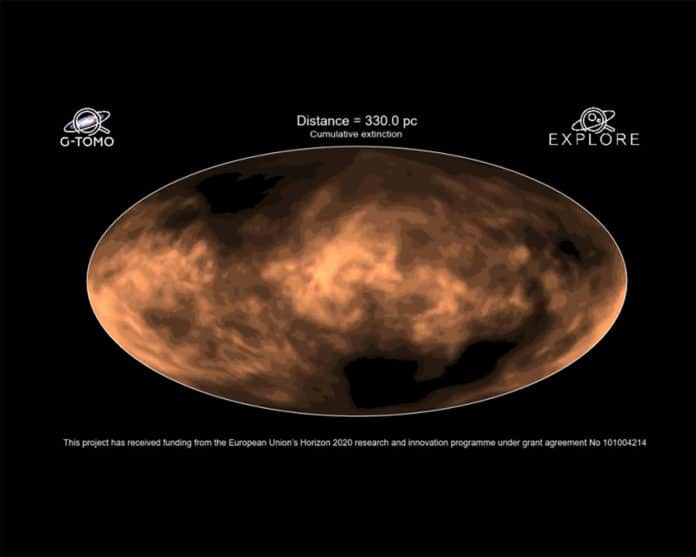Astronomers have produced an animation to model dust in the Milky Way based on fresh data from an interactive tool that uses information from the European Space Agency’s Gaia mission and other space science data sets. It reveals the outlines of our galaxy taking shape as we look further from Earth.
Nick Cox, a coordinator of the EXPLORE project, which is developing the tools, said, “Dust clouds are related to the formation and death of stars, so their distribution tells a story of how structures formed in the galaxy and how the galaxy evolves. The maps are also important for cosmologists in revealing regions where there is no dust, and we can have a clear, unobstructed view out of the Milky Way to study the Universe beyond, such as to make Deep Field observations with Hubble or the new James Webb Space Telescope.”
The animation depicts the gradual dust accumulation from Earth’s neighborhood to around 13000 lightyears towards the galactic center, or roughly 10% of the total distance across the Milky Way. Nearby, dust is everywhere, but farther away, it is easy to see how concentrated it is along the galactic plane. Additionally, two “windows” are shown, one above and one below the galactic plane.
To create this animation, researchers used tools that are part of a suite of applications designed to support studies of stars and galaxies and lunar exploration. These tools combine data from the Gaia mission and the 2MASS All Sky Survey.
Albert Zijlstra of the University of Manchester and the EXPLORE project said, “State-of-the-art machine learning and visual analytics have the power to enhance scientific return and discovery for space science missions greatly, but their use is still relatively novel in the field of astronomy. With a constant stream of new data, such as the recent third release of Gaia data in June 2022, we have an increasing wealth of information to mine – beyond the scope of what humans could process in a lifetime.”
“We need tools like the ones we are developing for EXPLORE to support scientific discovery, such as by helping us to characterize properties within the data or to pick out the most interesting or unusual features and structures.”
Journal Reference:
- Updated Gaia-2MASS 3D maps of Galactic interstellar dust, R. Lallement, J.L. Vergely, C. Babusiaux, and N.L.J. Cox. Astronomy & Astrophysics (2022). Volume 661, May 2022. DOI: 10.1051/0004-6361/202142846
